Detailed Audit and Financial Analysis Report: ABC Learning Case Study
VerifiedAdded on 2023/01/19
|19
|6813
|1
Report
AI Summary
This report provides a detailed analysis of the financial audit of ABC Learning, a major Australian childcare provider. It examines the company's financial performance through various analytical techniques, including trend analysis, common size analysis, Du Point analysis, and the Beneish M-Score model. The report delves into the audit scope, planning procedures, and the assessment of the control environment, including IT general controls. It also addresses responsibilities related to fraud, the role of internal audit, and the confirmation of auditor independence. The analysis highlights key risk areas, the audit approach, and the implications of the company's financial position, ultimately concluding with an overview of the company's financial health and the effectiveness of the audit process. The report also includes an executive summary, table of contents, and references, along with appendices containing financial data for analysis.
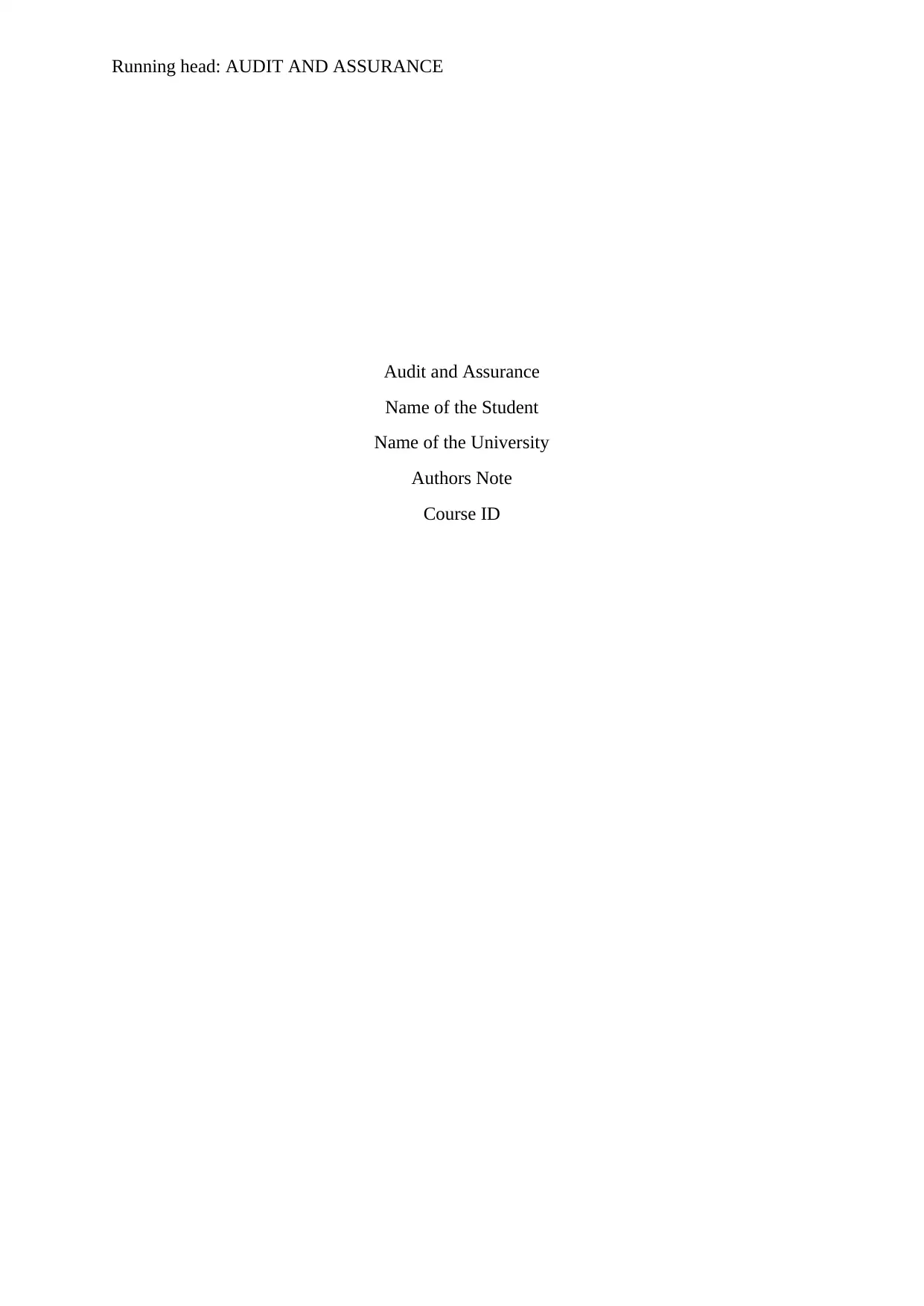
Running head: AUDIT AND ASSURANCE
Audit and Assurance
Name of the Student
Name of the University
Authors Note
Course ID
Audit and Assurance
Name of the Student
Name of the University
Authors Note
Course ID
Paraphrase This Document
Need a fresh take? Get an instant paraphrase of this document with our AI Paraphraser
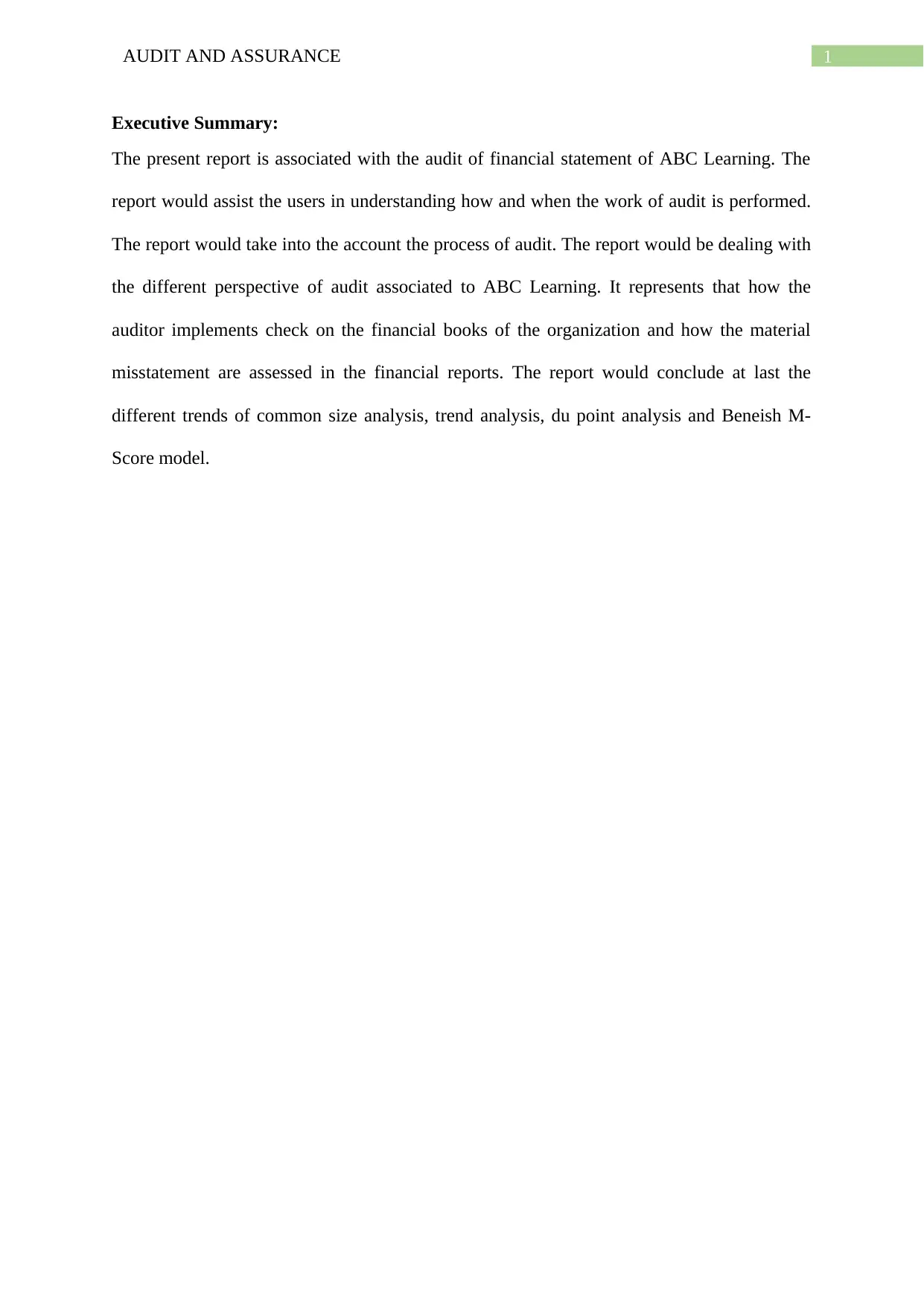
1AUDIT AND ASSURANCE
Executive Summary:
The present report is associated with the audit of financial statement of ABC Learning. The
report would assist the users in understanding how and when the work of audit is performed.
The report would take into the account the process of audit. The report would be dealing with
the different perspective of audit associated to ABC Learning. It represents that how the
auditor implements check on the financial books of the organization and how the material
misstatement are assessed in the financial reports. The report would conclude at last the
different trends of common size analysis, trend analysis, du point analysis and Beneish M-
Score model.
Executive Summary:
The present report is associated with the audit of financial statement of ABC Learning. The
report would assist the users in understanding how and when the work of audit is performed.
The report would take into the account the process of audit. The report would be dealing with
the different perspective of audit associated to ABC Learning. It represents that how the
auditor implements check on the financial books of the organization and how the material
misstatement are assessed in the financial reports. The report would conclude at last the
different trends of common size analysis, trend analysis, du point analysis and Beneish M-
Score model.

2AUDIT AND ASSURANCE
Table of Contents
Introduction................................................................................................................................5
Overview of Company:..............................................................................................................5
Company Development:.............................................................................................................6
Overall Analytical Review:........................................................................................................6
Audit scope and Approach:........................................................................................................8
Audit Planning Procedure:.........................................................................................................8
Scope of Work:..........................................................................................................................9
Control Environment Assessment:.............................................................................................9
IT General Controls Assessment:...............................................................................................9
Responsibilities related to Fraud:.............................................................................................10
Internal Audit:..........................................................................................................................10
Confirmation of Independence.................................................................................................10
Materiality:...............................................................................................................................11
Risk Assessment and Area of Audit Focus:.............................................................................11
Audit Engagement and Reporting:...........................................................................................12
Outline of Fees:........................................................................................................................12
Team of Audit:.........................................................................................................................12
Conclusion:..............................................................................................................................13
References:...............................................................................................................................14
Appendix:.................................................................................................................................16
Table of Contents
Introduction................................................................................................................................5
Overview of Company:..............................................................................................................5
Company Development:.............................................................................................................6
Overall Analytical Review:........................................................................................................6
Audit scope and Approach:........................................................................................................8
Audit Planning Procedure:.........................................................................................................8
Scope of Work:..........................................................................................................................9
Control Environment Assessment:.............................................................................................9
IT General Controls Assessment:...............................................................................................9
Responsibilities related to Fraud:.............................................................................................10
Internal Audit:..........................................................................................................................10
Confirmation of Independence.................................................................................................10
Materiality:...............................................................................................................................11
Risk Assessment and Area of Audit Focus:.............................................................................11
Audit Engagement and Reporting:...........................................................................................12
Outline of Fees:........................................................................................................................12
Team of Audit:.........................................................................................................................12
Conclusion:..............................................................................................................................13
References:...............................................................................................................................14
Appendix:.................................................................................................................................16
⊘ This is a preview!⊘
Do you want full access?
Subscribe today to unlock all pages.

Trusted by 1+ million students worldwide

3AUDIT AND ASSURANCE
Common Size Analysis Balance Sheet:...................................................................................16
Common Size Analysis Profit and Loss Account:...................................................................17
Trend Analysis Balance Sheet:................................................................................................17
Trend Analysis Profit and Loss Account:................................................................................18
Trend Analysis Cash Flow Statement:.....................................................................................18
Du Point Analysis:...................................................................................................................18
Beneish M-Score Model:.........................................................................................................19
Common Size Analysis Balance Sheet:...................................................................................16
Common Size Analysis Profit and Loss Account:...................................................................17
Trend Analysis Balance Sheet:................................................................................................17
Trend Analysis Profit and Loss Account:................................................................................18
Trend Analysis Cash Flow Statement:.....................................................................................18
Du Point Analysis:...................................................................................................................18
Beneish M-Score Model:.........................................................................................................19
Paraphrase This Document
Need a fresh take? Get an instant paraphrase of this document with our AI Paraphraser
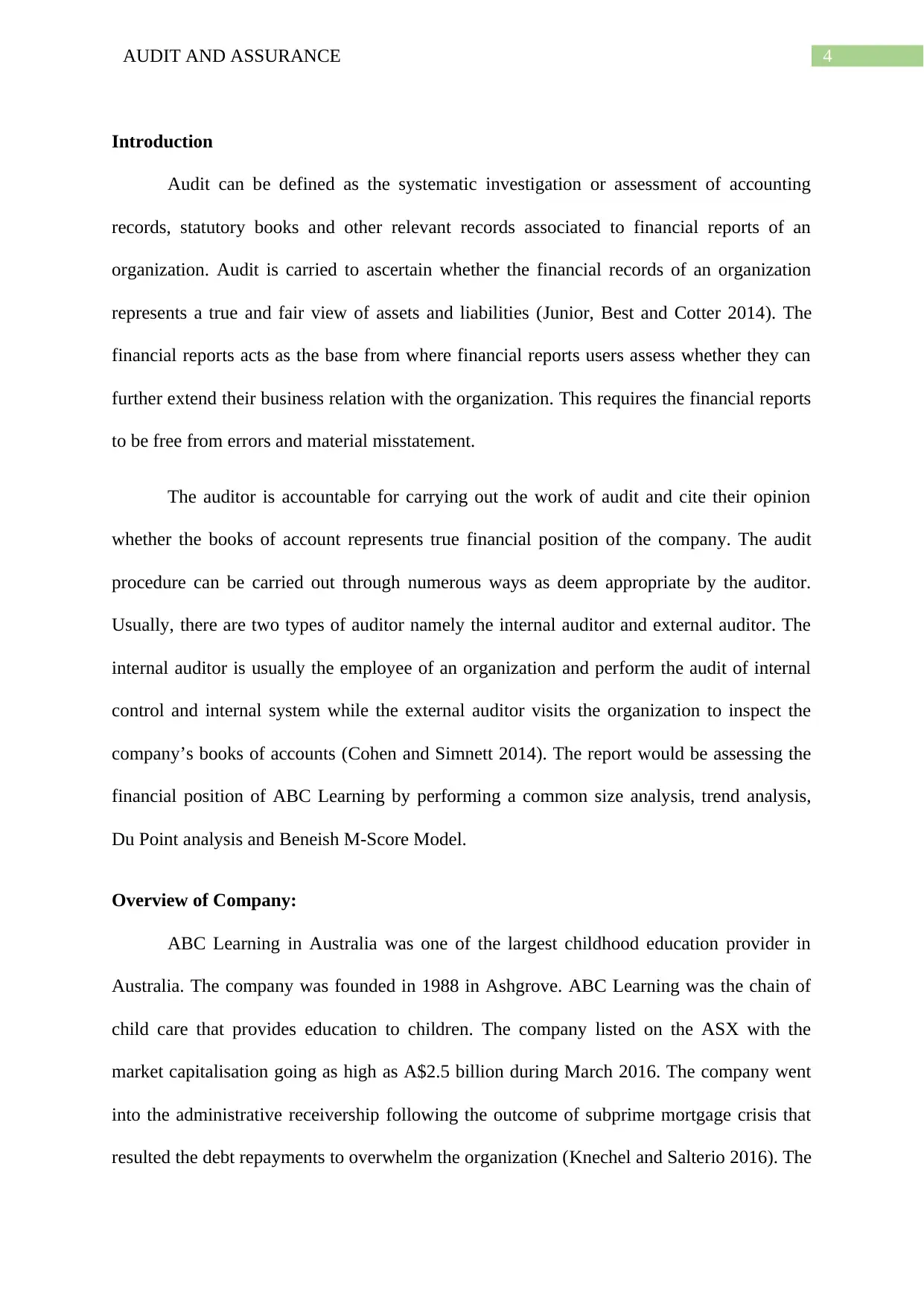
4AUDIT AND ASSURANCE
Introduction
Audit can be defined as the systematic investigation or assessment of accounting
records, statutory books and other relevant records associated to financial reports of an
organization. Audit is carried to ascertain whether the financial records of an organization
represents a true and fair view of assets and liabilities (Junior, Best and Cotter 2014). The
financial reports acts as the base from where financial reports users assess whether they can
further extend their business relation with the organization. This requires the financial reports
to be free from errors and material misstatement.
The auditor is accountable for carrying out the work of audit and cite their opinion
whether the books of account represents true financial position of the company. The audit
procedure can be carried out through numerous ways as deem appropriate by the auditor.
Usually, there are two types of auditor namely the internal auditor and external auditor. The
internal auditor is usually the employee of an organization and perform the audit of internal
control and internal system while the external auditor visits the organization to inspect the
company’s books of accounts (Cohen and Simnett 2014). The report would be assessing the
financial position of ABC Learning by performing a common size analysis, trend analysis,
Du Point analysis and Beneish M-Score Model.
Overview of Company:
ABC Learning in Australia was one of the largest childhood education provider in
Australia. The company was founded in 1988 in Ashgrove. ABC Learning was the chain of
child care that provides education to children. The company listed on the ASX with the
market capitalisation going as high as A$2.5 billion during March 2016. The company went
into the administrative receivership following the outcome of subprime mortgage crisis that
resulted the debt repayments to overwhelm the organization (Knechel and Salterio 2016). The
Introduction
Audit can be defined as the systematic investigation or assessment of accounting
records, statutory books and other relevant records associated to financial reports of an
organization. Audit is carried to ascertain whether the financial records of an organization
represents a true and fair view of assets and liabilities (Junior, Best and Cotter 2014). The
financial reports acts as the base from where financial reports users assess whether they can
further extend their business relation with the organization. This requires the financial reports
to be free from errors and material misstatement.
The auditor is accountable for carrying out the work of audit and cite their opinion
whether the books of account represents true financial position of the company. The audit
procedure can be carried out through numerous ways as deem appropriate by the auditor.
Usually, there are two types of auditor namely the internal auditor and external auditor. The
internal auditor is usually the employee of an organization and perform the audit of internal
control and internal system while the external auditor visits the organization to inspect the
company’s books of accounts (Cohen and Simnett 2014). The report would be assessing the
financial position of ABC Learning by performing a common size analysis, trend analysis,
Du Point analysis and Beneish M-Score Model.
Overview of Company:
ABC Learning in Australia was one of the largest childhood education provider in
Australia. The company was founded in 1988 in Ashgrove. ABC Learning was the chain of
child care that provides education to children. The company listed on the ASX with the
market capitalisation going as high as A$2.5 billion during March 2016. The company went
into the administrative receivership following the outcome of subprime mortgage crisis that
resulted the debt repayments to overwhelm the organization (Knechel and Salterio 2016). The
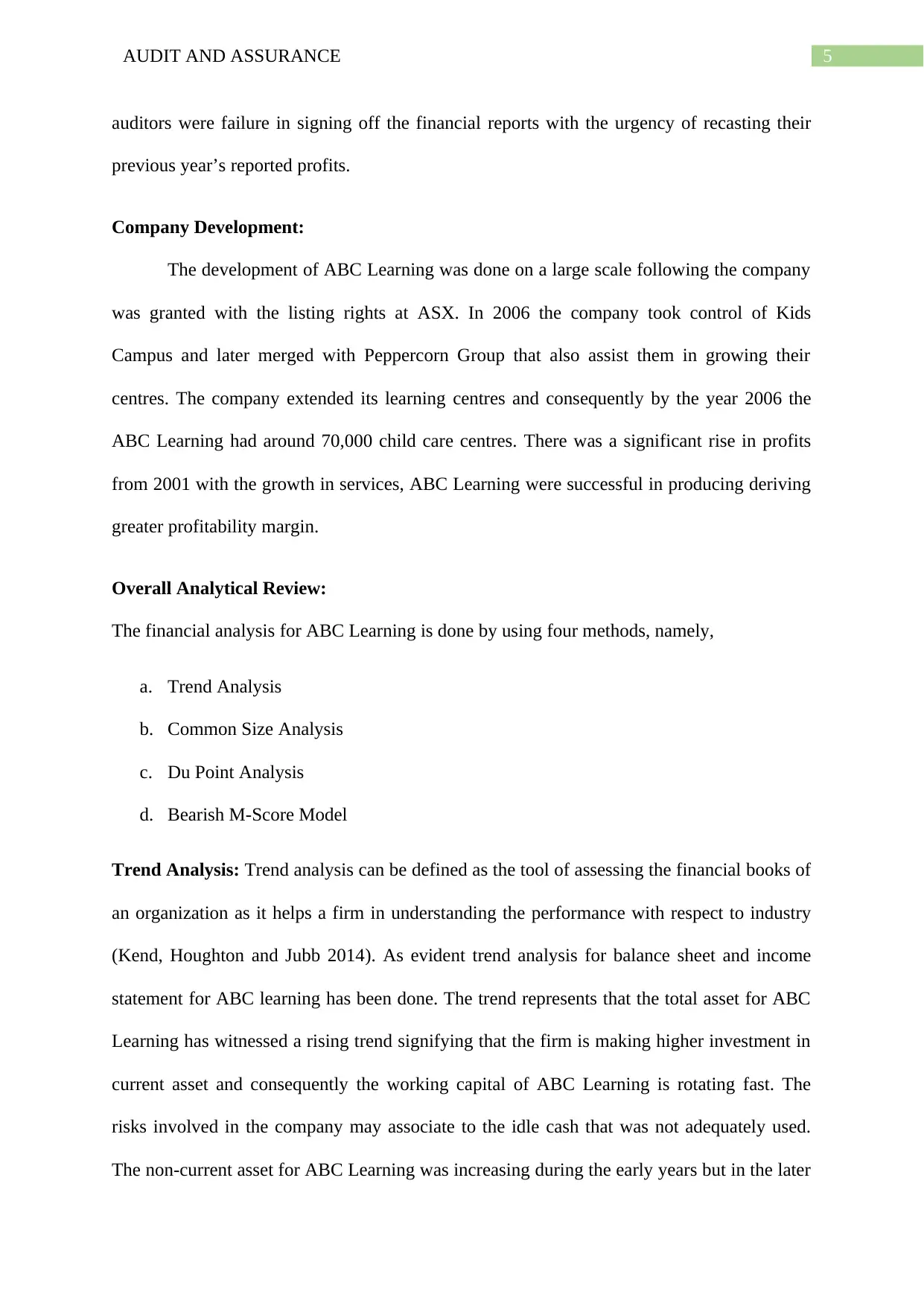
5AUDIT AND ASSURANCE
auditors were failure in signing off the financial reports with the urgency of recasting their
previous year’s reported profits.
Company Development:
The development of ABC Learning was done on a large scale following the company
was granted with the listing rights at ASX. In 2006 the company took control of Kids
Campus and later merged with Peppercorn Group that also assist them in growing their
centres. The company extended its learning centres and consequently by the year 2006 the
ABC Learning had around 70,000 child care centres. There was a significant rise in profits
from 2001 with the growth in services, ABC Learning were successful in producing deriving
greater profitability margin.
Overall Analytical Review:
The financial analysis for ABC Learning is done by using four methods, namely,
a. Trend Analysis
b. Common Size Analysis
c. Du Point Analysis
d. Bearish M-Score Model
Trend Analysis: Trend analysis can be defined as the tool of assessing the financial books of
an organization as it helps a firm in understanding the performance with respect to industry
(Kend, Houghton and Jubb 2014). As evident trend analysis for balance sheet and income
statement for ABC learning has been done. The trend represents that the total asset for ABC
Learning has witnessed a rising trend signifying that the firm is making higher investment in
current asset and consequently the working capital of ABC Learning is rotating fast. The
risks involved in the company may associate to the idle cash that was not adequately used.
The non-current asset for ABC Learning was increasing during the early years but in the later
auditors were failure in signing off the financial reports with the urgency of recasting their
previous year’s reported profits.
Company Development:
The development of ABC Learning was done on a large scale following the company
was granted with the listing rights at ASX. In 2006 the company took control of Kids
Campus and later merged with Peppercorn Group that also assist them in growing their
centres. The company extended its learning centres and consequently by the year 2006 the
ABC Learning had around 70,000 child care centres. There was a significant rise in profits
from 2001 with the growth in services, ABC Learning were successful in producing deriving
greater profitability margin.
Overall Analytical Review:
The financial analysis for ABC Learning is done by using four methods, namely,
a. Trend Analysis
b. Common Size Analysis
c. Du Point Analysis
d. Bearish M-Score Model
Trend Analysis: Trend analysis can be defined as the tool of assessing the financial books of
an organization as it helps a firm in understanding the performance with respect to industry
(Kend, Houghton and Jubb 2014). As evident trend analysis for balance sheet and income
statement for ABC learning has been done. The trend represents that the total asset for ABC
Learning has witnessed a rising trend signifying that the firm is making higher investment in
current asset and consequently the working capital of ABC Learning is rotating fast. The
risks involved in the company may associate to the idle cash that was not adequately used.
The non-current asset for ABC Learning was increasing during the early years but in the later
⊘ This is a preview!⊘
Do you want full access?
Subscribe today to unlock all pages.

Trusted by 1+ million students worldwide
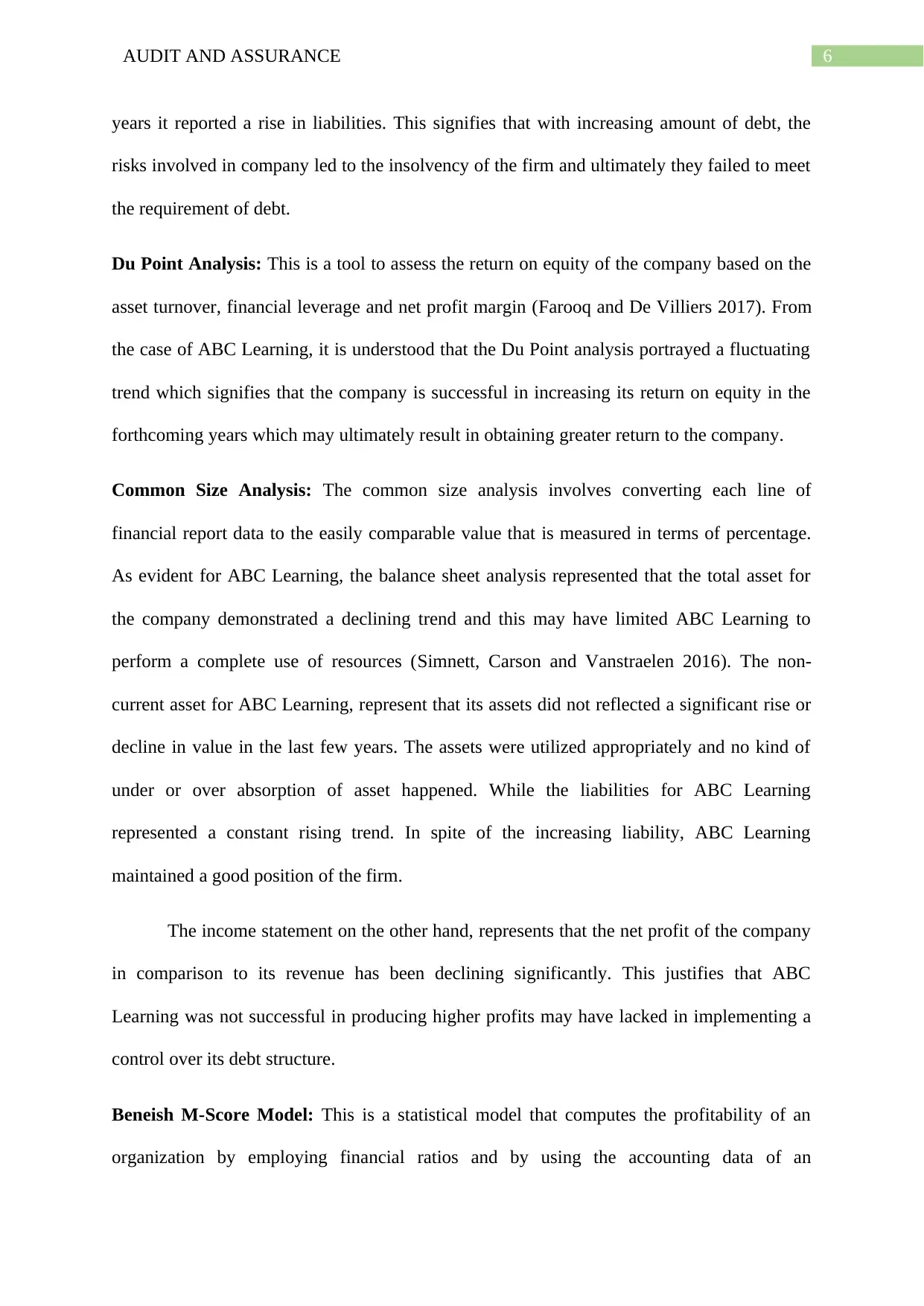
6AUDIT AND ASSURANCE
years it reported a rise in liabilities. This signifies that with increasing amount of debt, the
risks involved in company led to the insolvency of the firm and ultimately they failed to meet
the requirement of debt.
Du Point Analysis: This is a tool to assess the return on equity of the company based on the
asset turnover, financial leverage and net profit margin (Farooq and De Villiers 2017). From
the case of ABC Learning, it is understood that the Du Point analysis portrayed a fluctuating
trend which signifies that the company is successful in increasing its return on equity in the
forthcoming years which may ultimately result in obtaining greater return to the company.
Common Size Analysis: The common size analysis involves converting each line of
financial report data to the easily comparable value that is measured in terms of percentage.
As evident for ABC Learning, the balance sheet analysis represented that the total asset for
the company demonstrated a declining trend and this may have limited ABC Learning to
perform a complete use of resources (Simnett, Carson and Vanstraelen 2016). The non-
current asset for ABC Learning, represent that its assets did not reflected a significant rise or
decline in value in the last few years. The assets were utilized appropriately and no kind of
under or over absorption of asset happened. While the liabilities for ABC Learning
represented a constant rising trend. In spite of the increasing liability, ABC Learning
maintained a good position of the firm.
The income statement on the other hand, represents that the net profit of the company
in comparison to its revenue has been declining significantly. This justifies that ABC
Learning was not successful in producing higher profits may have lacked in implementing a
control over its debt structure.
Beneish M-Score Model: This is a statistical model that computes the profitability of an
organization by employing financial ratios and by using the accounting data of an
years it reported a rise in liabilities. This signifies that with increasing amount of debt, the
risks involved in company led to the insolvency of the firm and ultimately they failed to meet
the requirement of debt.
Du Point Analysis: This is a tool to assess the return on equity of the company based on the
asset turnover, financial leverage and net profit margin (Farooq and De Villiers 2017). From
the case of ABC Learning, it is understood that the Du Point analysis portrayed a fluctuating
trend which signifies that the company is successful in increasing its return on equity in the
forthcoming years which may ultimately result in obtaining greater return to the company.
Common Size Analysis: The common size analysis involves converting each line of
financial report data to the easily comparable value that is measured in terms of percentage.
As evident for ABC Learning, the balance sheet analysis represented that the total asset for
the company demonstrated a declining trend and this may have limited ABC Learning to
perform a complete use of resources (Simnett, Carson and Vanstraelen 2016). The non-
current asset for ABC Learning, represent that its assets did not reflected a significant rise or
decline in value in the last few years. The assets were utilized appropriately and no kind of
under or over absorption of asset happened. While the liabilities for ABC Learning
represented a constant rising trend. In spite of the increasing liability, ABC Learning
maintained a good position of the firm.
The income statement on the other hand, represents that the net profit of the company
in comparison to its revenue has been declining significantly. This justifies that ABC
Learning was not successful in producing higher profits may have lacked in implementing a
control over its debt structure.
Beneish M-Score Model: This is a statistical model that computes the profitability of an
organization by employing financial ratios and by using the accounting data of an
Paraphrase This Document
Need a fresh take? Get an instant paraphrase of this document with our AI Paraphraser
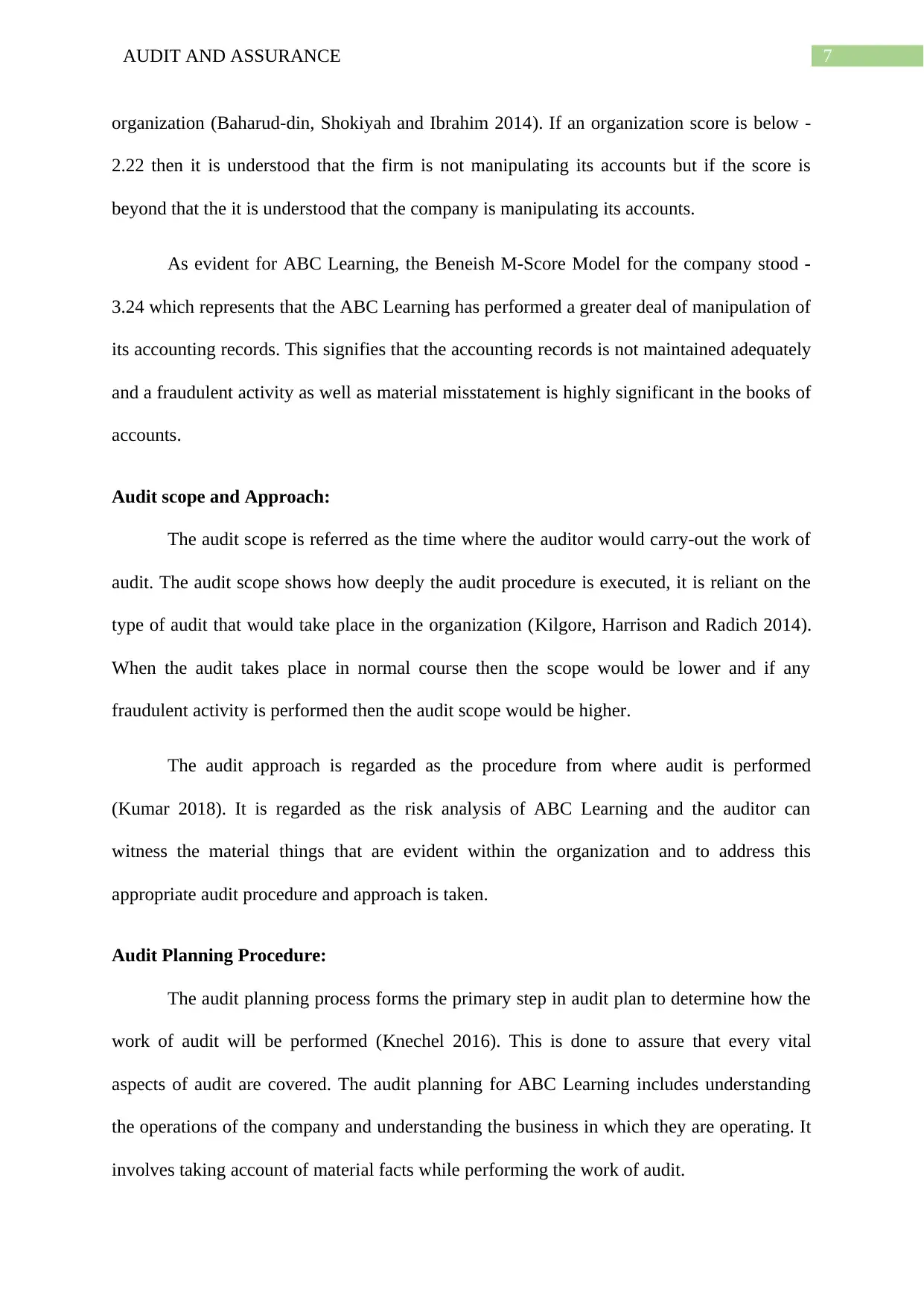
7AUDIT AND ASSURANCE
organization (Baharud-din, Shokiyah and Ibrahim 2014). If an organization score is below -
2.22 then it is understood that the firm is not manipulating its accounts but if the score is
beyond that the it is understood that the company is manipulating its accounts.
As evident for ABC Learning, the Beneish M-Score Model for the company stood -
3.24 which represents that the ABC Learning has performed a greater deal of manipulation of
its accounting records. This signifies that the accounting records is not maintained adequately
and a fraudulent activity as well as material misstatement is highly significant in the books of
accounts.
Audit scope and Approach:
The audit scope is referred as the time where the auditor would carry-out the work of
audit. The audit scope shows how deeply the audit procedure is executed, it is reliant on the
type of audit that would take place in the organization (Kilgore, Harrison and Radich 2014).
When the audit takes place in normal course then the scope would be lower and if any
fraudulent activity is performed then the audit scope would be higher.
The audit approach is regarded as the procedure from where audit is performed
(Kumar 2018). It is regarded as the risk analysis of ABC Learning and the auditor can
witness the material things that are evident within the organization and to address this
appropriate audit procedure and approach is taken.
Audit Planning Procedure:
The audit planning process forms the primary step in audit plan to determine how the
work of audit will be performed (Knechel 2016). This is done to assure that every vital
aspects of audit are covered. The audit planning for ABC Learning includes understanding
the operations of the company and understanding the business in which they are operating. It
involves taking account of material facts while performing the work of audit.
organization (Baharud-din, Shokiyah and Ibrahim 2014). If an organization score is below -
2.22 then it is understood that the firm is not manipulating its accounts but if the score is
beyond that the it is understood that the company is manipulating its accounts.
As evident for ABC Learning, the Beneish M-Score Model for the company stood -
3.24 which represents that the ABC Learning has performed a greater deal of manipulation of
its accounting records. This signifies that the accounting records is not maintained adequately
and a fraudulent activity as well as material misstatement is highly significant in the books of
accounts.
Audit scope and Approach:
The audit scope is referred as the time where the auditor would carry-out the work of
audit. The audit scope shows how deeply the audit procedure is executed, it is reliant on the
type of audit that would take place in the organization (Kilgore, Harrison and Radich 2014).
When the audit takes place in normal course then the scope would be lower and if any
fraudulent activity is performed then the audit scope would be higher.
The audit approach is regarded as the procedure from where audit is performed
(Kumar 2018). It is regarded as the risk analysis of ABC Learning and the auditor can
witness the material things that are evident within the organization and to address this
appropriate audit procedure and approach is taken.
Audit Planning Procedure:
The audit planning process forms the primary step in audit plan to determine how the
work of audit will be performed (Knechel 2016). This is done to assure that every vital
aspects of audit are covered. The audit planning for ABC Learning includes understanding
the operations of the company and understanding the business in which they are operating. It
involves taking account of material facts while performing the work of audit.

8AUDIT AND ASSURANCE
Scope of Work:
According to the ABC Learning the scope of audit involves checking the books of
accounts that was decided by the company and they were accountable for assessing the
financial books of account provided to the auditor (Kotb et al. 2018). Arguably, there was a
significant amount of flaws in the business model of ABC Learning and values did not
reflected a true and fair view of the company.
Control Environment Assessment:
The control environment assessment is regarded as the tool for assessing the internal
controls of ABC Learning. It places emphasis on how the internal control is managed by the
company. The auditor of ABC Learning should implement check on the necessary risks
assessment process that was followed by the company (Simnett and Huggins 2015). The
board’s decision of expanding the acquisition represent that ABC Learning was paying out
significant amount and the same was classified in the balance sheet as childcare licences with
less opportunity of cross selling other services. The company made error by classifying the
intangible assets which were not income producing in nature.
IT General Controls Assessment:
Under this control assessment process, the auditors of ABC Learning were required to
implement check on how the company is keeping their records and the systems adopted to
preserve those vital records (Laing and Hoy 2018). The IT controls helps in assuring that how
the ABC Learning was dealing with the records and no kind of misuse of the system is
performed. The auditor should check whether ABC Learning adopted any latest technology
and system in terms of the industry standard to preserve its records.
Scope of Work:
According to the ABC Learning the scope of audit involves checking the books of
accounts that was decided by the company and they were accountable for assessing the
financial books of account provided to the auditor (Kotb et al. 2018). Arguably, there was a
significant amount of flaws in the business model of ABC Learning and values did not
reflected a true and fair view of the company.
Control Environment Assessment:
The control environment assessment is regarded as the tool for assessing the internal
controls of ABC Learning. It places emphasis on how the internal control is managed by the
company. The auditor of ABC Learning should implement check on the necessary risks
assessment process that was followed by the company (Simnett and Huggins 2015). The
board’s decision of expanding the acquisition represent that ABC Learning was paying out
significant amount and the same was classified in the balance sheet as childcare licences with
less opportunity of cross selling other services. The company made error by classifying the
intangible assets which were not income producing in nature.
IT General Controls Assessment:
Under this control assessment process, the auditors of ABC Learning were required to
implement check on how the company is keeping their records and the systems adopted to
preserve those vital records (Laing and Hoy 2018). The IT controls helps in assuring that how
the ABC Learning was dealing with the records and no kind of misuse of the system is
performed. The auditor should check whether ABC Learning adopted any latest technology
and system in terms of the industry standard to preserve its records.
⊘ This is a preview!⊘
Do you want full access?
Subscribe today to unlock all pages.

Trusted by 1+ million students worldwide
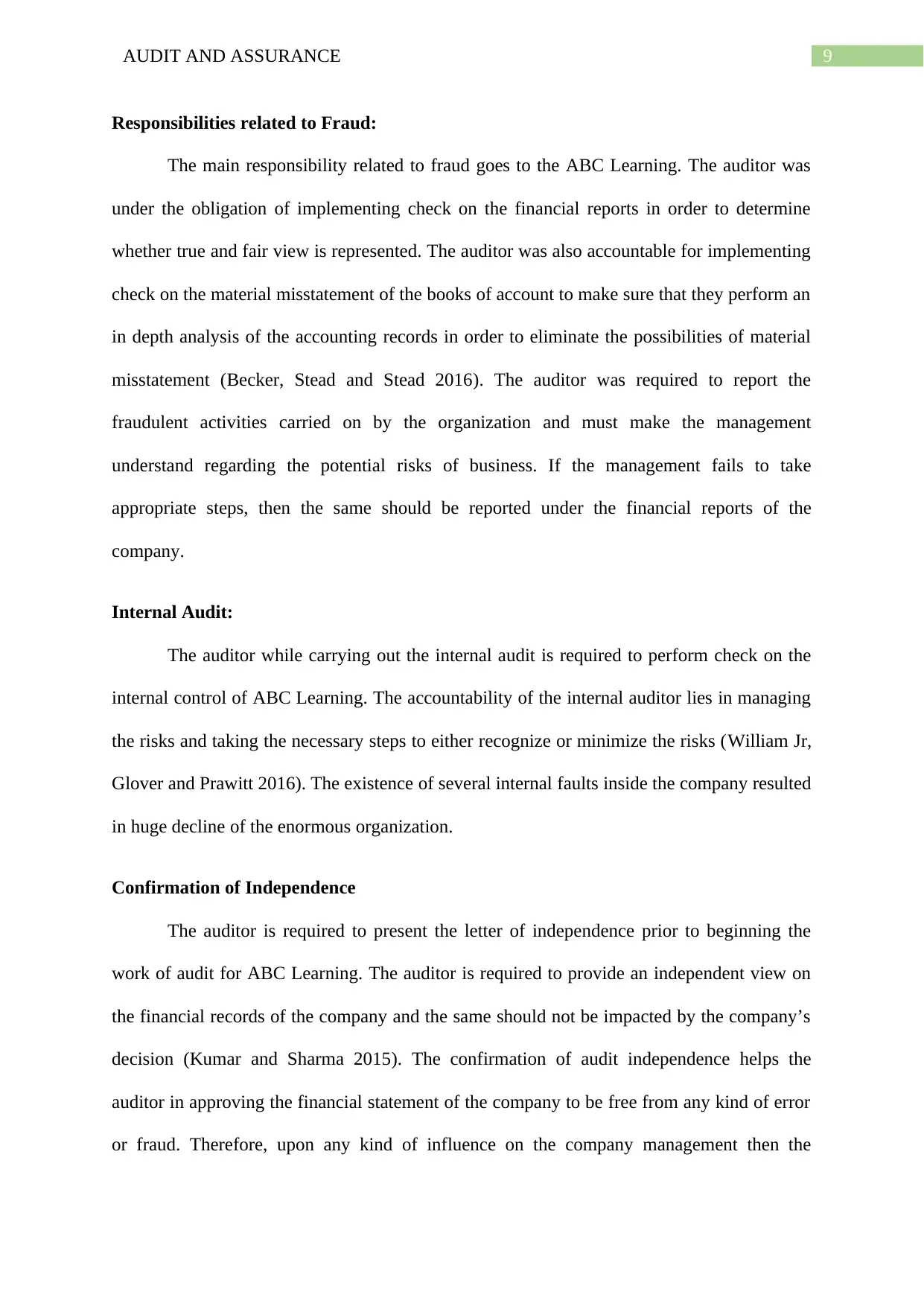
9AUDIT AND ASSURANCE
Responsibilities related to Fraud:
The main responsibility related to fraud goes to the ABC Learning. The auditor was
under the obligation of implementing check on the financial reports in order to determine
whether true and fair view is represented. The auditor was also accountable for implementing
check on the material misstatement of the books of account to make sure that they perform an
in depth analysis of the accounting records in order to eliminate the possibilities of material
misstatement (Becker, Stead and Stead 2016). The auditor was required to report the
fraudulent activities carried on by the organization and must make the management
understand regarding the potential risks of business. If the management fails to take
appropriate steps, then the same should be reported under the financial reports of the
company.
Internal Audit:
The auditor while carrying out the internal audit is required to perform check on the
internal control of ABC Learning. The accountability of the internal auditor lies in managing
the risks and taking the necessary steps to either recognize or minimize the risks (William Jr,
Glover and Prawitt 2016). The existence of several internal faults inside the company resulted
in huge decline of the enormous organization.
Confirmation of Independence
The auditor is required to present the letter of independence prior to beginning the
work of audit for ABC Learning. The auditor is required to provide an independent view on
the financial records of the company and the same should not be impacted by the company’s
decision (Kumar and Sharma 2015). The confirmation of audit independence helps the
auditor in approving the financial statement of the company to be free from any kind of error
or fraud. Therefore, upon any kind of influence on the company management then the
Responsibilities related to Fraud:
The main responsibility related to fraud goes to the ABC Learning. The auditor was
under the obligation of implementing check on the financial reports in order to determine
whether true and fair view is represented. The auditor was also accountable for implementing
check on the material misstatement of the books of account to make sure that they perform an
in depth analysis of the accounting records in order to eliminate the possibilities of material
misstatement (Becker, Stead and Stead 2016). The auditor was required to report the
fraudulent activities carried on by the organization and must make the management
understand regarding the potential risks of business. If the management fails to take
appropriate steps, then the same should be reported under the financial reports of the
company.
Internal Audit:
The auditor while carrying out the internal audit is required to perform check on the
internal control of ABC Learning. The accountability of the internal auditor lies in managing
the risks and taking the necessary steps to either recognize or minimize the risks (William Jr,
Glover and Prawitt 2016). The existence of several internal faults inside the company resulted
in huge decline of the enormous organization.
Confirmation of Independence
The auditor is required to present the letter of independence prior to beginning the
work of audit for ABC Learning. The auditor is required to provide an independent view on
the financial records of the company and the same should not be impacted by the company’s
decision (Kumar and Sharma 2015). The confirmation of audit independence helps the
auditor in approving the financial statement of the company to be free from any kind of error
or fraud. Therefore, upon any kind of influence on the company management then the
Paraphrase This Document
Need a fresh take? Get an instant paraphrase of this document with our AI Paraphraser

10AUDIT AND ASSURANCE
financial information would become fraudulent for the users of financial reports. The auditor
is under obligation of carrying out the work with professional behaviour and must not have
involvement of management. They must follow all the other principles while performing the
audit work. The auditor must assess the financial books based on their judgement and should
not be influenced by management decision.
Materiality:
The management of the ABC Learning have omitted the materiality which included
both the quantitative and qualitative records. The auditor was required to implement check on
both the materiality aspects of ABC Learning. Under the quantitative method the auditor was
required to check whether the financial transactions have been recorded appropriately and
should also determine the figures of each transaction. Ignoring any small gap can result in
huge material impact on the business (Cook, Bommel and Turnhout 2016). Whereas under
the qualitative aspects the auditor is required to check whether adequate disclosure of
financial information has been made and the way through which the disclosure are adjusted in
the financial statement.
Risk Assessment and Area of Audit Focus:
The auditor was under obligation of implementing check on the books of accounts of
ABC Learning and determine whether the represents portrays a correct view or not. The
auditor is required to emphasis on the investment made by ABC Learning are recorded
correctly and whether the returns generated are as per the industry norms. The notes to
accounts of ABC Learning in 2005 represents that the considerations regarding the disposal
of investment and properties is included into the gross operating revenue (Zeff 2016). While
under Notes 1 a curious note was presented which stated that goodwill upon consolidation is
eliminated by progressively lowering the carrying amount and once the discount goes past
financial information would become fraudulent for the users of financial reports. The auditor
is under obligation of carrying out the work with professional behaviour and must not have
involvement of management. They must follow all the other principles while performing the
audit work. The auditor must assess the financial books based on their judgement and should
not be influenced by management decision.
Materiality:
The management of the ABC Learning have omitted the materiality which included
both the quantitative and qualitative records. The auditor was required to implement check on
both the materiality aspects of ABC Learning. Under the quantitative method the auditor was
required to check whether the financial transactions have been recorded appropriately and
should also determine the figures of each transaction. Ignoring any small gap can result in
huge material impact on the business (Cook, Bommel and Turnhout 2016). Whereas under
the qualitative aspects the auditor is required to check whether adequate disclosure of
financial information has been made and the way through which the disclosure are adjusted in
the financial statement.
Risk Assessment and Area of Audit Focus:
The auditor was under obligation of implementing check on the books of accounts of
ABC Learning and determine whether the represents portrays a correct view or not. The
auditor is required to emphasis on the investment made by ABC Learning are recorded
correctly and whether the returns generated are as per the industry norms. The notes to
accounts of ABC Learning in 2005 represents that the considerations regarding the disposal
of investment and properties is included into the gross operating revenue (Zeff 2016). While
under Notes 1 a curious note was presented which stated that goodwill upon consolidation is
eliminated by progressively lowering the carrying amount and once the discount goes past
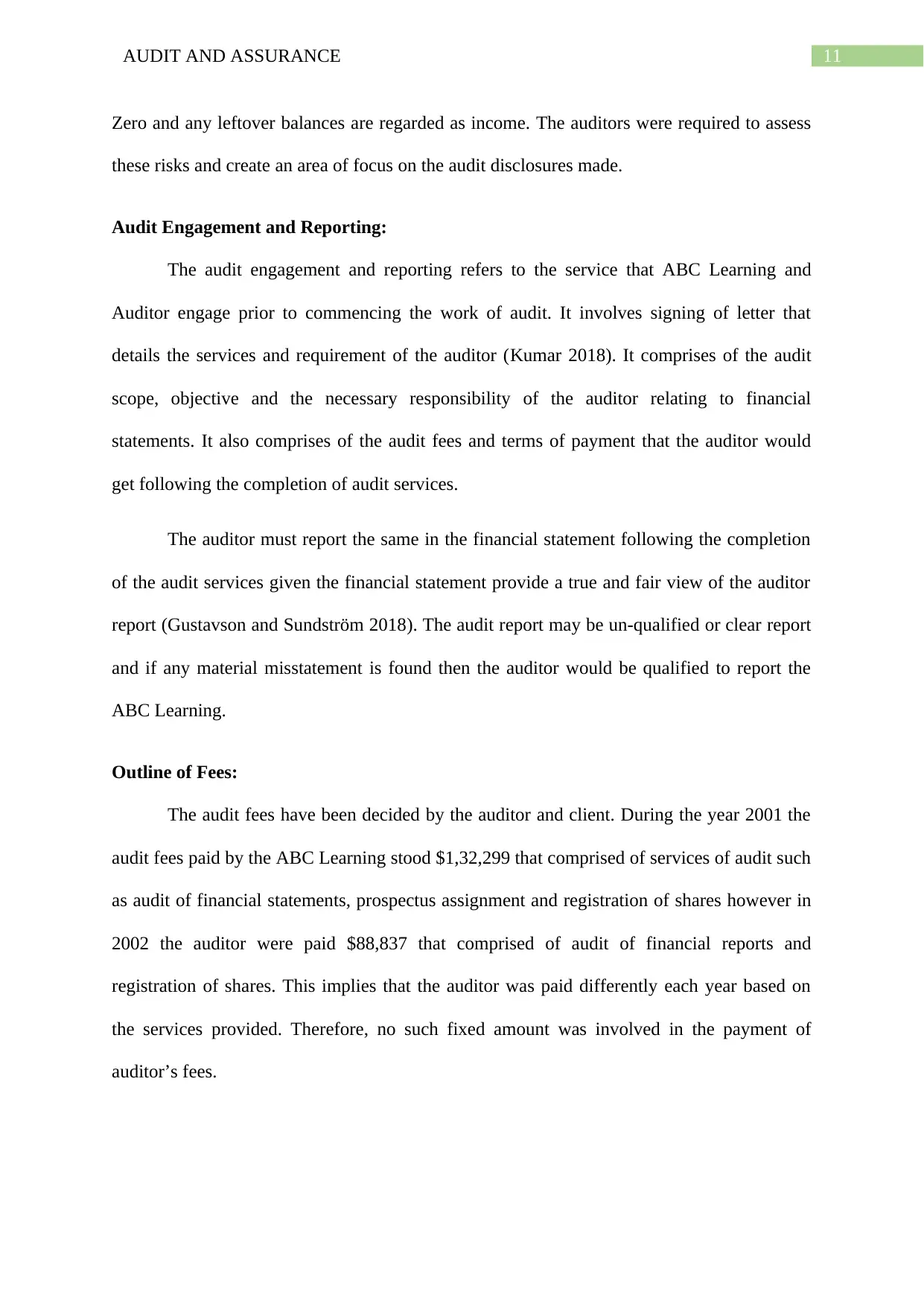
11AUDIT AND ASSURANCE
Zero and any leftover balances are regarded as income. The auditors were required to assess
these risks and create an area of focus on the audit disclosures made.
Audit Engagement and Reporting:
The audit engagement and reporting refers to the service that ABC Learning and
Auditor engage prior to commencing the work of audit. It involves signing of letter that
details the services and requirement of the auditor (Kumar 2018). It comprises of the audit
scope, objective and the necessary responsibility of the auditor relating to financial
statements. It also comprises of the audit fees and terms of payment that the auditor would
get following the completion of audit services.
The auditor must report the same in the financial statement following the completion
of the audit services given the financial statement provide a true and fair view of the auditor
report (Gustavson and Sundström 2018). The audit report may be un-qualified or clear report
and if any material misstatement is found then the auditor would be qualified to report the
ABC Learning.
Outline of Fees:
The audit fees have been decided by the auditor and client. During the year 2001 the
audit fees paid by the ABC Learning stood $1,32,299 that comprised of services of audit such
as audit of financial statements, prospectus assignment and registration of shares however in
2002 the auditor were paid $88,837 that comprised of audit of financial reports and
registration of shares. This implies that the auditor was paid differently each year based on
the services provided. Therefore, no such fixed amount was involved in the payment of
auditor’s fees.
Zero and any leftover balances are regarded as income. The auditors were required to assess
these risks and create an area of focus on the audit disclosures made.
Audit Engagement and Reporting:
The audit engagement and reporting refers to the service that ABC Learning and
Auditor engage prior to commencing the work of audit. It involves signing of letter that
details the services and requirement of the auditor (Kumar 2018). It comprises of the audit
scope, objective and the necessary responsibility of the auditor relating to financial
statements. It also comprises of the audit fees and terms of payment that the auditor would
get following the completion of audit services.
The auditor must report the same in the financial statement following the completion
of the audit services given the financial statement provide a true and fair view of the auditor
report (Gustavson and Sundström 2018). The audit report may be un-qualified or clear report
and if any material misstatement is found then the auditor would be qualified to report the
ABC Learning.
Outline of Fees:
The audit fees have been decided by the auditor and client. During the year 2001 the
audit fees paid by the ABC Learning stood $1,32,299 that comprised of services of audit such
as audit of financial statements, prospectus assignment and registration of shares however in
2002 the auditor were paid $88,837 that comprised of audit of financial reports and
registration of shares. This implies that the auditor was paid differently each year based on
the services provided. Therefore, no such fixed amount was involved in the payment of
auditor’s fees.
⊘ This is a preview!⊘
Do you want full access?
Subscribe today to unlock all pages.

Trusted by 1+ million students worldwide
1 out of 19
Related Documents
Your All-in-One AI-Powered Toolkit for Academic Success.
+13062052269
info@desklib.com
Available 24*7 on WhatsApp / Email
![[object Object]](/_next/static/media/star-bottom.7253800d.svg)
Unlock your academic potential
Copyright © 2020–2025 A2Z Services. All Rights Reserved. Developed and managed by ZUCOL.




